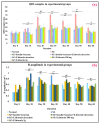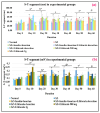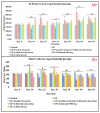Progression of electrophysiological impairments in diabetic cardiomyopathy and intervention using Enicostemma axillare
- PMID: 40365100
- PMCID: PMC12068667
- DOI: 10.55730/1300-0152.2733
Progression of electrophysiological impairments in diabetic cardiomyopathy and intervention using Enicostemma axillare
Abstract
Earlier studies widely reported advanced ventricular impairments only at the later stages of diabetic cardiomyopathy (DCM). The present study aimed to understand the duration-based early to late stages of cardiac electrophysiological impairments using electrocardiography (ECG) and intervention using Enicostemma axillare subsp. littorale. The experimental rats were streptozotocin (SZ)-induced diabetic rats that were administered E. axillare formulations as follows: (1) normal; (2) SZ - 40 mg/kg, single, i.p.); (3) SZ + insulin (2 U/day) + losartan (10 mg/kg); (4) SZ + insulin + losartan + E. axillare decoction (2 mL/day); (5) SZ + E. axillare decoction; (6) SZ + E. axillare (low dose-500 mg/kg), and (7) SZ + E. axillare (high dose-2 g/kg). Steady hyperglycemia was witnessed until day 5 followed by various elevated patterns until day 60 in the SZ group that was potentially treated with E. axillare formulations from day 20. ECG (lead II) revealed early significantly impaired ventricular events, namely widened QRS complex, elevated R-amplitude, and prolonged R-R interval from day 10 that were regulated using E. axillare decoction. Pearson's correlation analysis revealed a strong relationship between basal blood glucose (day 0) and impaired ECG parameters. This duration-based study therefore illustrated the progression of glycemic shifts, ventricular impairments, and their correlation besides establishing the interventional potential of E. axillare subsp. littorale towards these impairments associated with DCM. These glycemic-ECG impairments were substantiated by the increased blood HbA1c, serum NT-pro BNP, and LDH levels that were ameliorated by E. axillare subsp. littorale decoction. It was concluded that E. axillare subsp. littorale can restore early ventricular depolarization impairments, marking it as the reversible hypertrophic cardiomyopathic stage towards intervention in DCM.
Keywords: Blood glucose; cardiac hypertrophy; diabetes; diabetic cardiomyopathy; electrocardiography.
© TÜBİTAK.
Conflict of interest statement
Conflicts of interest: The authors declare no conflict of interest. The funders had no role in the design of the study; in the collection, analyses, or interpretation of data; in the writing of the manuscript, or in the decision to publish the results.
Figures









References
-
- Abukhalil MH, Althunibat OY, Aladaileh SH, Al-Amarat W, Obeidat HM, et al. Galangin attenuates diabetic cardiomyopathy through modulating oxidative stress, inflammation and apoptosis in rats. Biomedicine & pharmacotherapy = Biomedecine & Pharmacotherapie. 2021;138:111410. doi: 10.1016/j.biopha.2021.111410. - DOI - PubMed
-
- Al-Fahham AA. Development of New LSD Formula when Numbers of Observations Are Unequal. Open Journal of Statistics. 2018;8:258–263. doi: 10.4236/ojs.2018.82016. - DOI
LinkOut - more resources
Full Text Sources
Research Materials
